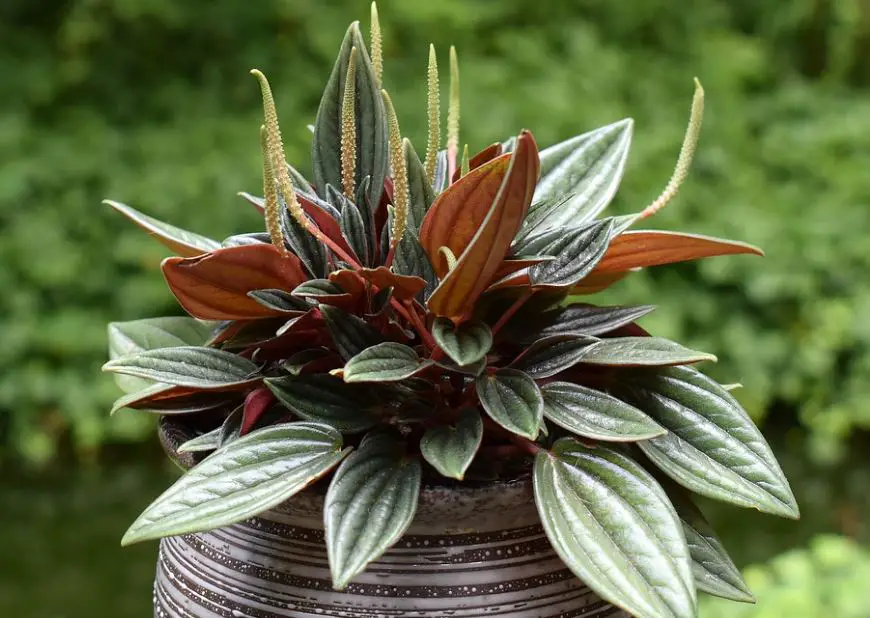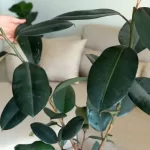In the search for different Types of Peperomia? Look no further and opt for a lovely peperomia plant. These pretty plants offer a different structure than other plants, but it is also regarded as one of the most popular houseplants. Continue reading and learn more about different types of peperomia.
If you are determined on getting a houseplant, you can’t go wrong with types of peperomia. Whether you’re expanding your collection or simply starting out, peperomia is a must. This group of plants is one of the most frequently seen in homes and offices all over. And there’s good reason a live peperomia plant is a low maintenance houseplant; peperomias are compact, tropical plants with fleshy leaves and ornamental foliage. It is a superb choice of plant.
It can be tricky to identify many types; you have the small peperomia varieties and the large peperomia houseplants. One thing is for sure; you’ll find a type to suit every modern interior. Discover how types of peperomia plants can enhance your decor.
Types of Peperomia
Burpee’s Peperomia’ Marble
Air purifying plant is long-lasting and easy to care for. Peperomia’ Marble’ prefers indirect medium to high light and thrives in moderate temperatures.
Its lush green leaves and flowering white petals provide an organic contrast to any home or apartment.
Allow soil to dry slightly between watering for optimal care.
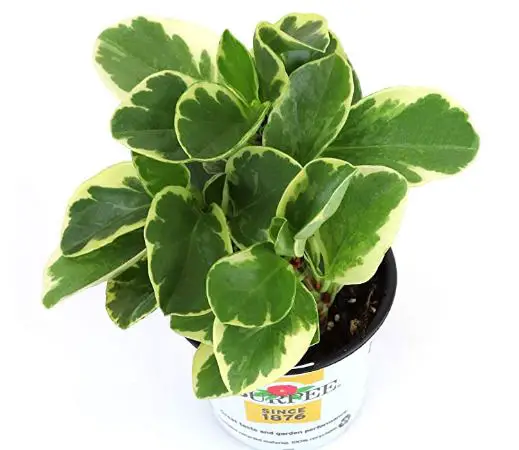
Features:
- Indoors
- Air purifying
- Easy care
String of Hearts Peperomia prostrata
This is the vine that holds leaves like coins. Some of them have markings that look just like a peace sign.
Easy to grow as a house plant or in a terrarium or fairy garden. Trim as needed. Provide bright, indirect light.
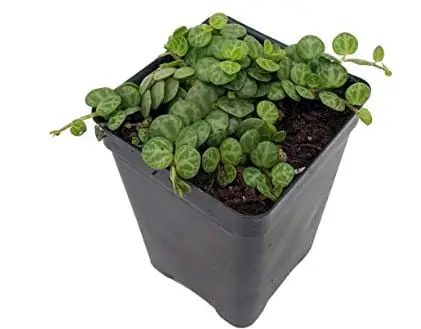
Features:
- Hardy in zones 9-11 or indoors
- Easy to grow indoors or out
Peperomia Rosso
This plant is a beauty with glossy green leaves accompanied by bright red undersides. Its oval-shaped leaves are deeply grooved, adding depth and texture.
Flower spikes will appear with bright light, adding even more character to this easy-to-grow plant.
It can be propagated with leaf or stem cuttings. Cut a healthy piece and place it in soil or water. You should have a new plant within a few weeks.
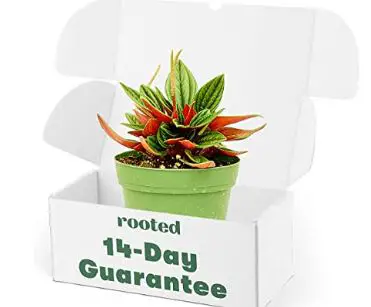
Features:
- Regular Watering
- Pet friendly
- Medium to bright indirect light
Hope Peperomia
Thick green rounded leaves with a trailing habit and low water requirements, this plant is a survivor. Provide bright, indirect light and water when dry. Trim as needed.
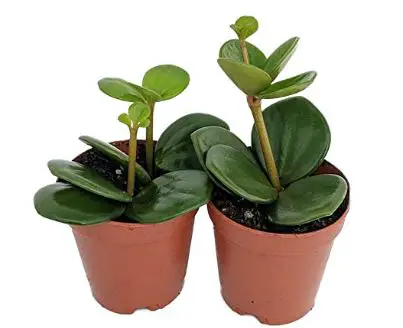
Features:
- Trim as needed
- Very easy to grow
- Prefers bright, indirect light
- Water when dry
Red Ecuador Peperomia
This small-growing Peperomia is a real gem with red stems supporting succulent, ovate, glossy red leaves with a green window on their upper surface.
The inflorescence is a greenish spike with a mousy odor on a red peduncle. Native to dry mountains of Southern Ecuador.
Provide bright, indirect light and water when on the dry side. Trim as needed.
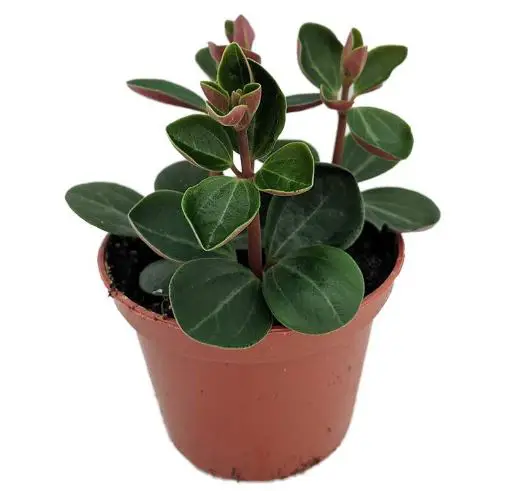
Features:
- Very easy to grow
- Prefers bright, indirect light
- Water when dry
How to care for peperomia plants?
- Grow peperomia plants in well-draining potting soil and bright indirect light.
- Water peperomias as often as the top layer of soil dries and mist the leaves occasionally to increase humidity.
- Peperomia, also known as Radiator plants, thrive in average room temperature; between 65°F and 80°F (18°C – 26°C).
- Prune peperomia foliage in spring and occasionally fertilize during spring and summer.
Common Questions About Types of Peperomia
What are peperomia plants?
Peperomia is a tropical perennial plant genus in the family Piperaceae. Peperomia plants are epiphytes; meaning their roots absorb moisture and nutrients from the air and water. Because of their small size and low maintenance.
Is peperomia an excellent indoor plant?
Resembling the fan-favorite rubber plant, just tinier, Peperomia plants belong in the peppercorn family, Piperaceae. Peperomia make excellent houseplants, are low maintenance, and clean the air. Peperomias make good houseplants that are generally easy to care for and have minimal nutritional needs.
How many types of peperomia are there?
There are over 1,500 species of peperomia, many of which are popular houseplants. Some small peperomia varieties have thick, succulent-like oval leaves. Other more significant types of peperomia have rippled or striped green heart-shaped leaves.
Does peperomia need light?
Grow peperomias with all green leaves in bright light, but not direct sunlight. A west window or east window shaded by a transparent curtain works best. Peperomias with variegated leaves can tolerate more light and need more light to generate bright colors.
Is peperomia a succulent?
Peperomias are small plants that are similar to hoyas in their care. Both are succulent, like fleshy leaves and stems. They make beautiful houseplants and can be found in both hanging and upright forms.
Although they have thick, fleshy leaves, peperomias are not types of succulents. Unlike succulents, peperomias prefer high humidity and require more water than succulent or cactus plants.
What are common types of indoor peperomia?
Peperomia Obtusifolia (Baby Rubber Plant)
The baby rubber plant is a small, bushy succulent-like variety of Peperomia with tall upright stems.
Their glossy evergreen leaves are slightly concave, creating a somewhat cupped shape. These plants usually grow to about 25-30cm tall and require bright light to maintain their lush green color.
Peperomia Argyreia (Watermelon Peperomia)
Watermelon peperomia plants have large, heart-shaped, green leaves with silver stripes which closely resemble the skin of a watermelon.
The leaves are attached to beautiful red stems, which grow as a bushy rosette, making this plant ideal as a ground cover or grouped with other plants indoors.
Watermelon peperomia plants can produce insignificant flowers which look like greenish spikes; however, their unmistakable charm is all about the foliage.
Peperomia Rotundifolia (Trailing Jade Peperomia)
Trailing jade peperomias have small, round, fleshy leaves similar to that of a succulent. These leaves are attached to lengthy trailing stems, which will intertwine as they grow, giving a bushy appearance.
Trailing jade peperomias thrive on moisture, warm temperatures, and shady conditions within their natural habitat.
Peperomia Clusiifolia (Peperomia Jelly)
Other common names include red edge peperomia, Ginny peperomia, and tricolor peperomia. This plant’s easy-to-grow manner, compact form, and colorful pointed oval leaves make it an ideal houseplant.
The peperomia jelly is a gorgeous houseplant with uniquely multicolored leaves. The leaves will usually appear green in the center, followed by a cream-colored strip that fades to pink and then red around the edges.
Peperomia Scandens (Cupid Peperomia)
There are two types of peperomia scandens, one with green leaves and the other with variegated leaves. Both versions of this peperomia are trailing plants with thick, glossy, heart-shaped leaves.
Peperomia Orba (Teardrop Peperomia)
Teardrop peperomias feature small, oval-shaped leaves with varying types of foliage depending on the cultivar.
They will generally grow twice as wide as they do tall, appearing as a small bushy plant. They can either be a solid green color, light green to almost yellow, or variegated green with golden-yellow edges.
Peperomia Caperata ‘Emerald’ (Emerald Ripple Peperomia)
Ripple peperomia plants display eye-catching shiny, oval leaves with a distinct corrugated appearance. These plants remain pretty compact in their growth form, making them perfect for a shelf or tabletop.
As with most peperomias, they prefer bright indirect light with moderate watering and occasional misting.
Peperomia Caperata ‘Rosso’ (Peperomia Rosso)
Their glossy, skinny, pointed leaves are deeply grooved, giving them a rippled appearance. Also growing as a compact, bushy plant, their dark leaf color makes them ideal for rooms with minimal access to sunlight. However, as with other flowering peperomias, they will need at least 11 hours of light to bloom.
Peperomia Prostrata (String Of Turtles)
A string of turtles peperomia plants is a very dainty and delicate species of peperomia. They feature long, cascading strings of tiny circular leaves which can fall off quite easily.
The leaves appear to have light green veins which resemble a turtle’s shell.
Peperomia Tetraphylla ‘Hope’ (Peperomia Hope)
Also known as the acorn peperomia or four-leaved peperomia, peperomia ‘hope’ is best suited for hanging baskets. They have long, trailing stems and thick oval leaves with a similar appearance to the tailing jade peperomia.
Read: Types of Jade Plants

